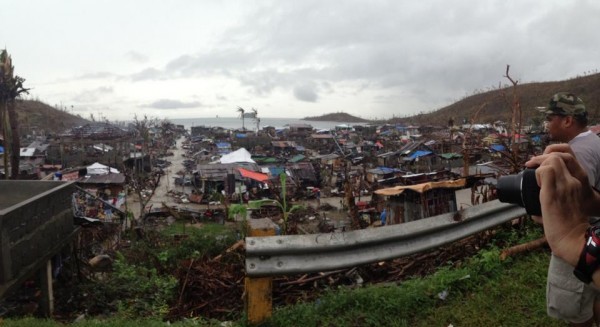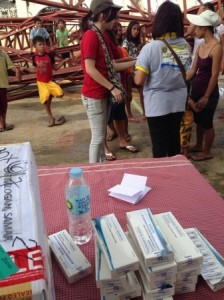Yolanda battered people already struggling
Beyond the post-super typhoon media spotlight, one medical team uncovered a bleak reality: In many small coastal towns, Yolanda battered people who were already struggling.
In hard-to-reach areas of Samar, a team of seven — five doctors, a dentist and a nurse — found victims of the devastation who were already victims even before the storm hit.
“They are really crying out for help,” Jette Po-Major, the dentist-member of the team said.
In one barangay (village), the team helped 1,800 families, their “first time ever to be visited by a medical team since time immemorial.” At another, residents were “running to our venue just to seek medical attention.”
“Cases of gangrene, dermal problems from the storm, oral abscesses in children” were common among many residents, many of whom were seeing a doctor for the very first time. “Ngayon lang nakakita ng duktor.”
Article continues after this advertisementThe team saw no less than 300 patients per visit, Jette said. On Sunday, she wrote: “Today, we reached around 650 patients or even more because we just didn’t have time to record them anymore.”
Article continues after this advertisementAlong the Samar coast, the picture she painted was grim.
As they entered the hard-hit coastal areas, she said, the colors of the mountains “would slowly transform from green to brown and black.”
The town of Giporlos “looks like a town that’s been completely obliterated.” Another town, called Lawaan, was “practically along the highway but we were the first med team to go there and serve directly one week after the typhoon,” Jette recalled. In one barangay, people had to go to the town proper to seek medical attention. But they simply couldn’t afford to go there. “No one bothered to reach them,” Jette said.
That was true for the other towns and villages where people wrestled with a range of ailments.
Babies were lethargic “probably because they are dehydrated,” Jette said.
“Fungal infections in the feet are common because their feet are always soaked in water,” she said. “They have no roofs over their houses so upper respiratory tract infections are not uncommon.”
The team came across a woman “whose feet were already gangrenous with maggots because she could not afford to go to the town proper to seek medical aid,” Jette recalled.
One team member, Dr. Cristina Cruz, is a veteran of many medical missions. But Jette said it was the first time she encountered women asking for sleep aids “they are so traumatized that they no longer are able to sleep at night.’” A woman wakes up at four in the morning “because she remembers that that was the time that the winds were at their strongest.”
One patient broke down during a consultation, saying, “Naalala ko ‘yung hangin. I remember the wind. Hindi ko kaya.”
A mother said one of her children had become afraid of water and wind. Her entire family died in Tacloban, and the only family she had left was her three children.
Basic dental care had been a luxury to many. “I’ve had two patients who
most probably have oral cancer and am just praying that he eventually finds money to seek medical attention,” Jette said.
In Balangiga, more than 600 people lined up for hours through vicious weather changes, from rain to scorching heat, to seek medical help.
When the team announced that they were moving on, one woman started crying, Jette recalled.
Leaving Balangiga, the historic town famous for its role in a tragic chapter in the Philippine-American War when U.S. forces massacred Filipino civilians, turned out to be one of the low points for Jette.
“My conscience still bothers me because of this one patient I rejected in Balangiga because we were all packing and it was late. I didn’t know at that time we were closing down that they had to travel lengths just to reach us. That patient was pleading with me but I was extremely tired after having to work on more than 23 patients and all extractions at that. I can never forget that look of desperation and I keep on telling myself that I should have done more.”
And they will do more. The team plans to return after the holidays.
And this is also part of the reason why I’m writing about this.
I had mentioned the Facebook campaign my friends, Jane Po and Lloyd Nebres and I launched, and now aligned with a similar effort by Ruben and Data Tolentino Canlas, to raise money to buy water purification supplies. It’s a small effort, but we’ve managed to send eight boxes of those critical supplies.
But the key component of this grassroots effort was working with a team directly involved in the relief effort — and to follow their lead.
We found one in the Oplan Sagip Samar, composed of Drs. Fran Bernardino, Cecilia Evangelista, Ma. Cristina Cruz, Fatima Gansatao and Daphne Villanueva; a nurse Mia Atanacio; and Jette. The team also included Marc Soong and Gary Ramirez, who helped distribute relief goods.
They made sure the water purification supplies reached the victims. They’ve been giving us updates and have even posted pictures.
In recent op-ed in the New York Times, Mari Kuraishi of the GlobalGiving Foundation, spoke of the “mixed messages” from the coverage of the impact of Yolanda.
This was highlighted by the perception that the Aquino administration had been trying to downplay the number of casualties and by PNoy’s own stunningly shortsighted public statements on the casualty count shortly after the tragedy began.
She cited three “confusing” headlines on the Yolanda tragedy.
“Worst Storm Ever Kills up to 10,000.”
“Philippine Official Fired for Estimate of 10,000 Dead from Typhoon”
“Typhoon Haiyan Death Toll in Philippines Reduced by Government?”
“With mixed messages like this, the generous soul is stopped dead in its tracks, forced into thinking, ‘Wait. How do I know what’s going on?’” Kuraishi wrote.
But there is a way to help and not feel that that assistance is not going to waste, she said. The key, she said, is “to go local.”
“Being close matters,” Kuraishi said. “Local Filipino organizations were there before the disaster, and they will be there after.” And it’s best to give to groups that offer “rich feedback.”
“When you give to an organization, it’s reasonable to expect that you can find out where that money went, to whom, for what,” she added.
And this is important to remember as we face what’s bound to be a long struggle.
A marathon, a friend of mine called it.
Going local, working in small groups with people you trust, and following the lead of reliable teams on the ground, is a way for us to sustain the effort and not to burn out. This is also a way not to get discouraged by the incoherence and incompetence in high places, and by the ploys of trapos looking to take advantage of this tragedy.
For this is also a protracted journey to fix what, in many ways, was already broken even before Yolanda hit.
“We want people to be made aware that it’s not just the typhoon that’s an issue here but it’s just one of the many things that should change in this whole system,” she said. “The typhoon just served as an eye opener for us.”
Visit (and Like) the Kuwento page on Facebook at www.facebook.com/boyingpimentel On Twitter @boyingpimentel


